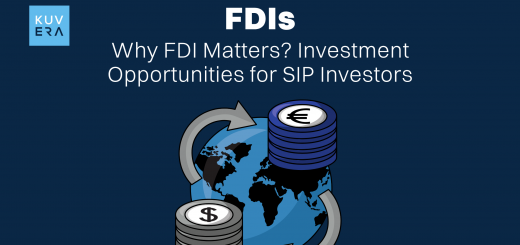The market seems to be looking all red!
What can you do here: stay invested or flee with your returns so far?
Let us find out!
The world of investing often preaches the virtue of patience, advocating a long-term approach to weather market fluctuations.
While this advice holds true in many scenarios, there exists a hidden, insidious cost associated with “holding on” to investments that have fundamentally deteriorated, particularly during periods of intense market turmoil.
This is not about short-term volatility in Indian stock market; it concerns investments that have lost their core value, where clinging to them can lead to significant financial and emotional burdens.
Understanding this distinction is crucial for making smart investment decisions.
Loss Aversion in Investing
Human psychology plays a profound role in our financial decisions. A deeply ingrained bias, known as “loss aversion,” causes individuals to fear losses far more intensely than they appreciate equivalent gains. This psychological quirk often explains why people cling to failing ventures, undesirable jobs, or, most pertinent to our discussion, declining investments. The emotional pain of realising a loss, of admitting a mistake, can be far more powerful than the logical imperative to cut ties and move forward.
Behavioural scientists Daniel Kahneman and Amos Tversky, through their groundbreaking work on Prospect Theory, demonstrated that the pain of losing feels roughly twice as strong as the pleasure of gaining an equivalent amount. This fundamental asymmetry in how we perceive gains and losses can lead to irrational decision-making, particularly when facing volatility in the Indian stock market. Investors might avoid selling a depreciating asset because it feels like an admission of failure, even when selling represents the most prudent course of action. The ego often gets intertwined with investment outcomes, blurring the lines of objectivity.
When Patience Becomes a Trap
Many investors have experienced the painful consequences of loss aversion during market downturns. One can recall the brutal financial crisis of 2008, where unprepared investors grappled with unprecedented market meltdowns. For some, the reluctance to sell a fundamentally flawed investment, even as it plummeted, became a costly lesson.
Consider an example: An individual had invested in a relatively small company, excited by its ambitious plans to expand into new markets and become an agribusiness giant. This dream, fueled by aggressive expansion and market optimism, drove the stock’s price to significant highs before the 2008 market bubble burst. As the crisis unfolded, the company’s stock was not spared. Initially, the investor dismissed the decline as a mere market overreaction, believing in an inevitable recovery.
However, subsequent news revealed a grim reality: operational delays, financial mismanagement, unpaid wages, and land disputes plagued the company’s African ventures. What once seemed like a visionary expansion had devolved into an operational disaster. Despite the clear deterioration of the underlying business, the investor found it incredibly difficult to sell. The stock had fallen by over 50%, then 60%, and continued its descent. “It’s only a loss if I sell,” became a persistent, misleading mantra. This clinging to the idea of avoiding a “realised” loss prevented rational action. By the time the investor finally accepted reality and sold, the stock’s value was almost negligible, down by nearly 90%.
The True Cost Beyond Just Financial Loss
The most significant cost of holding onto a fundamentally flawed investment extends beyond just the monetary loss reflected in a portfolio statement. The real damage encompasses:
- Lost Time: Capital tied up in a depreciating asset represents time wasted. That same money could have been reinvested in stronger, more promising companies, generating returns and contributing to wealth creation.
- Lost Opportunity: Every rupee held in a bad investment is a rupee not available for a better opportunity. This “opportunity cost” can significantly hinder your overall financial progress.
- Psychological Toll: The constant anxiety of watching an investment plummet, coupled with the internal conflict of admitting a mistake, can be emotionally draining. It can paralyse decision-making and lead to further inaction.
The market remains indifferent to an investor’s emotions or the price at which they initially purchased a stock. A stock does not “remember” your entry price, nor does it “owe” you a recovery.
When to Cut Your Losses
While patience is a virtue in investing, especially when it comes to riding out temporary volatility in Indian stock market for fundamentally sound businesses, it transforms into a dangerous folly when the underlying business fundamentals deteriorate permanently.
Here are key principles for making a smart investment decision during challenging times:
1. Distinguish Between Price Drop and Value Destruction
A temporary price decline in a good business is an opportunity. A permanent destruction of the underlying business value, however, warrants an exit. Consistently evaluate whether the business you own still aligns with its initial investment thesis.
2. Separate Ego from Investing
Investment decisions should be based on logic and analysis, not on the need to avoid admitting a mistake. The market rewards clear thinking, not ego protection.
3. Ask the Crucial Question
If you did not own this investment today, would you buy it at its current price? If the honest answer is “no,” it might be time to sell. This simple question helps to overcome the sunk cost fallacy.
4. Embrace the Power of Moving On
Letting go of a failing investment creates space for better opportunities. This principle applies not just to stocks but also to other aspects of life where clinging to what is no longer working can hinder progress.
5. Utilise SIP Investment Plans Wisely
For long-term goals, a SIP investment plan remains an excellent strategy to navigate market volatility. However, if your existing SIP investment is directed towards a fundamentally flawed fund or stock, stopping and re-evaluating becomes a critical smart investment move. Regularly review “what is SIP investment” doing for your portfolio.
6. Continuous Learning
Every investment experience, especially a painful one, offers valuable lessons. Learn to recognise mistakes quickly and implement clearer rules for when to exit. This commitment to continuous learning is arguably the best investing you can do.
Wrapping Up
The cost of holding onto unsuitable investments during market turmoil extends far beyond financial figures. It encompasses lost time, missed opportunities, and immense psychological strain. While the concept of “holding on” often implies resilience, true strength in investing lies in the ability to discern when patience becomes stagnation. Embracing the courage to let go of what is no longer working is a liberating act, allowing you to reallocate capital, regain focus, and make room for genuinely smart investment decisions that will contribute to your long-term financial well-being.
Interested in how we think about the markets?
Read more: Zen And The Art Of Investing
Watch here: Learn about the F&O craze in India












